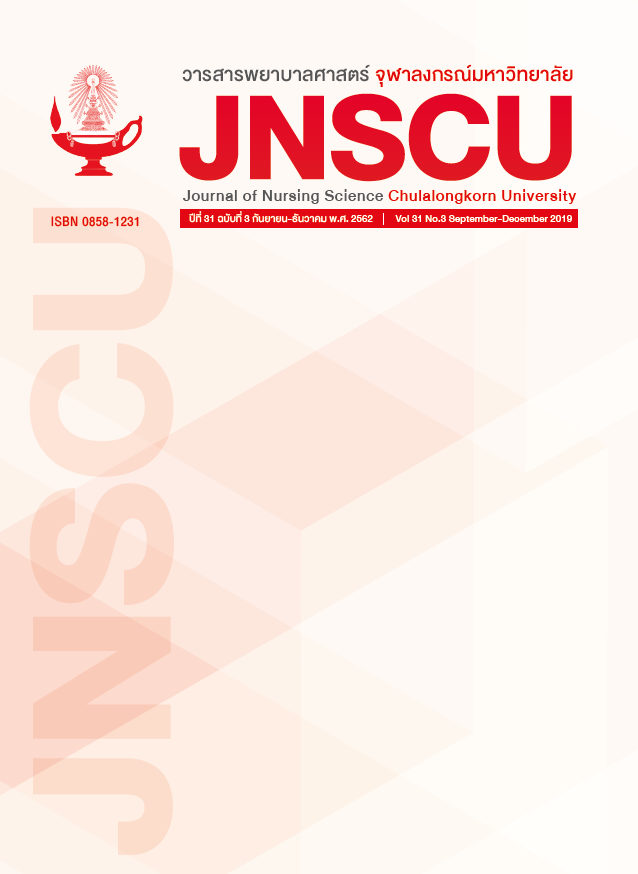The Factors Related to HIV Prevention Behavior among Myanmarese Youth Migrant Workers
Keywords:
HIV prevention behaviors, Youths, Migrant workers, MyanmareseAbstract
Purpose: To investigate factors related to HIV preventive behaviors among Myanmarese youth migrant workers.
Design: descriptive correlation research study
Method: The sampling consisted of 120 young Myanmar migrant workers Visited to the hospital under the Department of Medical Services, Bangkok area between October and November 2018. Data were collected using a set of questionnaires. The questionnaires included questionnaires about personal information, knowledge, attitude toward HIV infection, perceived susceptibility to HIV infection, self-efficacy for HIV prevention and HIV prevention behavior. Data were analyzed using descriptive and inferential statistics. Correlations were identified using the Pearson product-moment correlation coefficient, and the point biserial correlation coefficient.
Finding: The results revealed that knowledge of HIV prevention (r=0.45), attitude toward HIV prevention (r = 0.53), perceived susceptibility to HIV (r=0.55), and self-efficacy for HIV prevention (r=0.43) were positively and significantly related to HIV prevention behavior (p<.05) among Myanmar youth migrant workers in Bangkok, Thailand. The results further revealed that the non-correlation factors for HIV prevention behaviors were sex, marital status, and education level.
Conclusion: The findings of this study can be used in planning and organizing projects to increase the recognition of perceived susceptibility to HIV, perceived self-efficacy for HIV prevention, attitude toward HIV prevention, and increased knowledge of HIV prevention in Bangkok, Thailand.
References
UNAIDS. The Gap Report (Migrants). Joint United Nations Programme on HIV/AIDS [Internet]. 2014 [cited 2018 Jan 10]. Available from: http://www.unaids.org/sites/default/files/media_asset/gobalAIDS-update-2016_en.pdf
Meyoutam C, Chaimanee A. AIDS among immigrant and Thai HIV infected workers cared at Nopparat Rajathanee Hospital. Thamassat medical journal 2017; 18(1):71-77. (In Thai)
Tanaiswrryanggul S, Seeno W, Pongpan S. Report on the situation of infection among migrant workers in Thailand. Nonthaburi: Group of AIDS epidemiological surveillance system for TB And sexually transmitted diseases Bureau of Epidemiology, Department of Disease Control, Ministry of Public Health, Nonthaburi; 2013. (In Thai)
UNAIDS. Global AIDS Update. Joint United Nations Programme on HIV/AIDS [Internet]. 2016 [cited 2017 Dec 30]. Available from: http://www.unaids.org/sites/default/files/media_asset/gobalAIDS-update-2016_en.pdf
Chamratrithirong A, Boonchalaksi W, et al. Promotion of AIDS prevention in migrant workers (Pha Mit-2 Project). Nakhon Pathom: Institute for Population and Social Research Mahidol University; 2010. (In Thai)
UNICEF. Country programme document 2012 [Internet]. 2012 [cited 2018 Dec10]. Available from:
http://www.unicef.org/about/execboard/files/Thailand_final_approved_2012-2016-English_10Feb2012_.pdf 7,
Htoo KM, Panza A. Factors Associated with Unsafe Sex Behaviors for Prevention of HIV/AIDS T ransmission Among Myanmar Migrant Fishermen in Ranong, Thailand. Journal of Health Research 2009; 23(Suppl.): 45-47.
Maung KT, Soe HHK, Than NN, Madan SS. High Risk Behavior, Knowledge and Attitude of HIV/AIDS among Workers in Factories Manufacturing Alcohol in Mandalay, Myanmar. World Journal of AIDS 2013; 3(2): 147-53. Doi: 10.4236/ wja.2013.32019.
Khaing NN. HIV/AIDS Preventive Behavior: Factors underlying condom use among Myanmar migrant workers in Samut Sakhon Province, Thailand [Doctoral dissertation, MA Thesis in Health Social Science]. Nakhon Pathom: Mahidol University; 1998. (In Thai)
Chamratrithirong A, and Boonchalaksi W. Prevention of HIV/AIDS among migrant workers in Thailand project (PHAMIT): the impact survey 2008. Institute for Population and Social Research, Mahidol University; 2009. (In Thai)
Nyunt KS, Kiewkarnka B, Sillabutra J Safe sex behavior towards HIV/AIDS among Myanmar reproductive aged migrants in Muang district, Samutsakhon province, Thailand [Doctoral dissertation]. Nakon Pratom: Mahidol University; 2008.(In Thai)
Saechee P, Thato R. Factors predicting condom use behavior of Myanmar male workers in industrial factories, the upper southern region of Thailand. Princess of Naradhiwas University Journal 2017; 9(2): 26-37. (In Thai)
Klam C, Tan K. Factors influencing AIDS preventive behaviors of male migrant workers in Myanmar following the sea fishery Samut Sakhon Province [Master's thesis Faculty of Public Health, Health Education]. Nakhon Pathom. Mahidol University; 1998. (In Thai)
World Health Organization. HIV/AIDS Fact Sheet update [Internet]. 2016 [cited
Dec 30]. Available from: http://www.who.int/mediacentre/factsheets/fs360/en/.
Fisher JD, Fisher WA, Shuper PA. The Information-Motivation-Behavioral Skills Model of HIV preventive behavior. Emerging theories in health promotion practice and research 2009; 2: 21-64.
Cohen J. Statistical power analysis for the behavioral sciences.New York: Lawerence Enlbaum associates publishers;1998.
Bloom BS. Handbook on Formative and summation Evaluation of student learning. New York: Mc Graw Hall; 1971.
Best JW. Research in education. New Jersey:Prentice Hall; 1981.
Ajzen I, Fishbein M. Understanding attitudes and predicting social behavior. Englewood Cliffs, NJ: Prentice-Hall1980.
Haehapruk J. Factors affecting the prevention behavior of AIDS among foreign workers In Mueang District Ratchaburi Province [Master’s Thesis Faculty of Public Health]. Nakon Pratom: Mahidol University; 1999. (In Thai)
Downloads
Published
Issue
Section
License
ลิขสิทธิ์ของบทความที่ตีพิมพ์เป็นของวารสารพยาบาลศาสตร์ จุฬาลงกรณ์มหาวิทยาลัย ทั้งฉบับตีพิมพ์เป็นรูปเล่มและเอกสารออนไลน์



